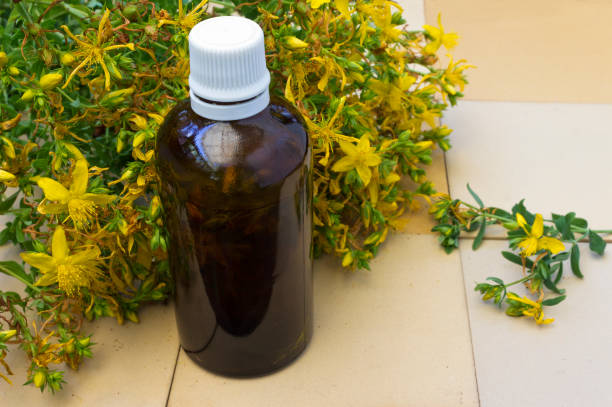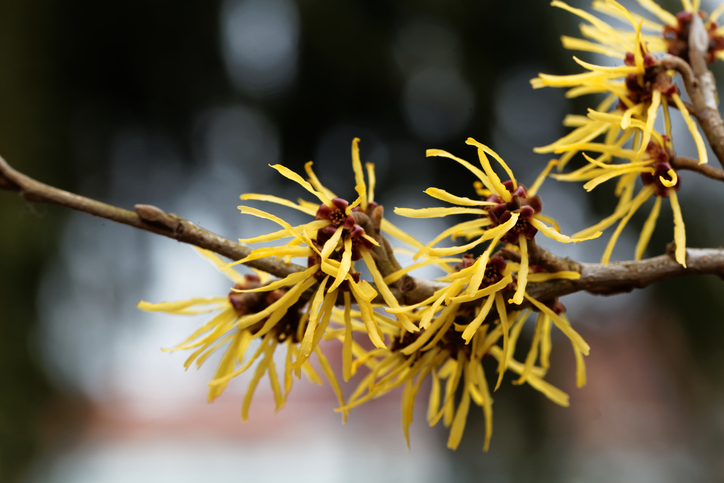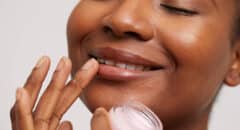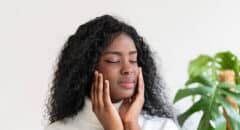
It's not alcohol or peroxide, but what is it? That was the question I asked when I found out about witch hazel. It sounds like something from the old days but I never really knew what it could do for your body. Once I found out, I saw witch hazel in a whole new light and started using it almost daily!
Witch hazel (which has the species name Hamamelis virginiana), a type of plant native to North America, is a member of the Hamamelidaceae plant family. Sometimes also called winter bloom, the leaves, and bark from the plant are used to make a skin-healing astringent that’s capable of naturally reducing acne, blisters, insect bites, poison ivy, inflammation and much more. It goes back to being widely used for medicinal purposes by American Indians. Now, many more people swear by it too. Here are some of the favorite uses for this wonder product:
1. Fights Adult & Child Acne
As a natural home remedy for acne, applying witch hazel to acne-prone skin can help slow down inflammation, redness, oiliness, and bleeding. As a natural cleanser, it’s capable of reducing bacteria growth on the skin and speeds up the time needed to heal infections or scabs.
Another benefit for sensitive skin is that it reduces the look of pores (although no product can actually shrink pores) and helps stop excess oil production, sweating, and the development of blackheads or whiteheads, which can contribute to embarrassing breakouts.
Instead of opening up a pimple and making the problem worse, apply witch hazel directly to the skin wherever you notice a zit or breakout forming. It’s even more effective when used in combination with other antibacterials like tea tree oil, coconut oil or apple cider vinegar.
Apply witch hazel with a clean cotton ball up to several times per day anywhere you experience irritation, starting slowly and giving your skin time to adjust.
2. Clears Puffy (Baggy) Eyes Quickly
Puffy eyes are another common skin problem that many people face, it can be caused by allergies, stress, overindulging in alcohol, sun exposure, cigarette smoking, and many other factors.
The next time you wake up and find yourself with puffy eyes, be sure to have some witch hazel around, and you’ll have a quick fix for that problem.
Witch hazel is known to tighten skin, which helps reduce under-eye baggage and puffiness. Just soak some cotton balls with witch hazel, and apply it to closed eyes. Let it remain for five minutes or so, allowing it to soak into the skin. Repeat one more time for severe puffiness. As it can be more effective if it’s cool, storing your witch hazel in the refrigerator is a good idea, particularly if this is the main reason you plan to use it.

3. Hair and Scalp Cleanser
Want to grow longer, stronger, more beautiful hair? Use witch hazel on your hair to help reduce oil buildup — which leaves your hair shinier, healthier and more volumized. It’s also great for removing hair odors, helping with an irritated scalp, or speeding up healing from any bites or acne at the base of the neck when you’re prone to sweating.
One study conducted by the Center for Dermatology and Disease in Zurich, Switzerland, found that shampoo containing witch hazel extract helped soothe patients’ irritated scalps, redness, itching and inflammation. After testing the effects of witch hazel on 1,373 patients, a percentage of patients reported improvement in symptoms and better tolerance of other hair products.
Add several drops to your shampoo or make your own hair wash using coconut oil, argan oil, witch hazel, and other cleansing essential oils like lemon or orange oil.
4. Underarm Dark Spot Remover
Witch hazel can also be used as a natural deodorant that also doubles as a dark spot remover under your arms. To use it instead of your regular stick or aerosol deodorant, pour a generous amount onto a large cotton pad and dab liberally under arms, letting it dry before dressing. For those with thick underarm hair, using witch hazel in a spray bottle to thoroughly penetrate the hair and reach the skin may be necessary for effective odor control.
5. Eczema Soother
If you’re suffering from eczema, witch hazel can help with that too, thanks to its anti-inflammatory properties. It not only helps stop that incessant itching, but it improves symptoms like scaling, redness, burning and even scarring. One study found that patients with eczema who were treated with witch hazel on one arm, and a non-steroidal cream on the other over three weeks, experienced just as effective relief in improving symptoms with the witch hazel as compared to the cream.
Simply apply witch hazel onto affected areas of the skin twice a day.
6. Hemorrhoid Healer
Witch hazel also acts as a hemorrhoids home remedy. You can apply witch hazel water to the skin to help lower pain and inflammation caused by uncomfortable hemorrhoids. It’s useful for relieving itching, irritation, bleeding and burning from hemorrhoids as well.
Most experts recommend using hazel water (Hamamelis liquid extract diluted with water) up to six times a day on irritated skin or after every bowel movement.
7. Protects Skin From Air Pollution
Because of its pore-minimizing benefits, witch hazel may offer skin protection against pollutants in the air. By applying witch hazel at the start of the day, you can help prepare your face for the pollutants to which it will be exposed throughout the day.
When pollutants attach to the skin, they can weaken the skin barrier. A weaker skin barrier means you are more likely to have ultraviolet (UV) damage, dryness, wrinkles, and hyperpigmentation (darker patches of skin).
Air pollution has also been linked to flares in acne, so using witch hazel may help in the prevention of air pollution-related acne, as well.
Following a daily skincare routine that includes a witch oil-containing product might protect against such pollutants. Because of this, witch hazel extract is an ingredient that many manufacturers include in their anti-pollution skincare products.
Side Effects You Should Pay Attention To
Witch hazel is a natural remedy that is generally safe for cosmetic and other topical uses.18 If any reaction occurs in the area where you applied the product, wash the area with soap and water.19
Because it is an astringent, witch hazel can be drying. If you are using more than one topical acne treatment, you are more likely to experience irritation and drying. If this occurs, use only one topical acne medication at a time.20
While it won’t lead to serious injury, witch hazel can cause inflammation or be painful if it gets into your eye.19 If witch hazel happens to get into your eyes, you should rinse your eyes with water.21
Some literature mentions that witch hazel is used in herbal teas or ingested orally as a natural treatment for different health conditions. However, the U.S. Food & Drug Administration requires that all astringent products, including witch hazel, have the warning label, “For external use only.”21 Plus, if taken orally in large doses, witch hazel may lead to gastrointestinal side effects like liver damage due to the presence of tannins, a naturally occurring compound in the plant.
How To Properly Use Witch Hazel
Witch hazel can be used safely by most people on the face, scalp, and other parts of the body. You should read the product’s label for specific directions, but here is general guidance for how to apply witch hazel:
- For your face: Put the solution on a cotton ball or cleansing pad and gently wipe your skin.
- For your body: Apply witch hazel directly to the sunburn, bug bite, scrape, or cut.
- For hemorrhoids: Witch hazel products for treating hemorrhoids come in different forms. How it’s used can depend on which product you are using. For example, if you are using a hazel witch pad, pat the affected area and then throw away the pad.15 If you are using a wipe, you will gently wipe, pat, or blot the affected area.
- For your scalp: Massage the shampoo into your hair and rinse it out.









